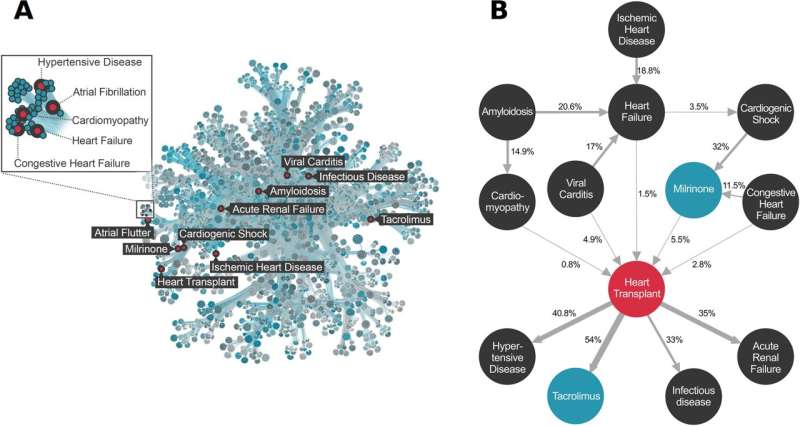Artificial intelligence identifies individuals at risk for heart disease complications


For the first time, University of Utah Health scientists have shown that artificial intelligence could lead to better ways to predict the onset and course of cardiovascular disease. The researchers, working in conjunction with physicians from Intermountain Primary Children’s Hospital, developed unique computational tools to precisely measure the synergistic effects of existing medical conditions on the heart and blood vessels.
The researchers say this comprehensive approach could help physicians foresee, prevent, or treat serious heart problems, perhaps even before a patient is aware of the underlying condition.
Although the study only focused on cardiovascular disease, the researchers believe it could have far broader implications. In fact, they suggest that these findings could eventually lead to a new era of personalized, preventive medicine. Doctors would proactively contact patients to alert them to potential ailments and what can be done to alleviate the problem.
“We can turn to AI to help refine the risk for virtually every medical diagnosis,” says Martin Tristani-Firouzi, M.D. the study’s corresponding author and a pediatric cardiologist at U of U Health and Intermountain Primary Children’s Hospital, and scientist at the Nora Eccles Harrison Cardiovascular Research and Training Institute. “The risk of cancer, the risk of thyroid surgery, the risk of diabetes—any medical term you can imagine.”
The study appears in the online journal PLOS Digital Health.
Current methods for calculating the combined effects of various risk factors—such as demographics and medical history—on cardiovascular disease are often imprecise and subjective, according to Mark Yandell, Ph.D., senior author of the study, a professor of human genetics, H.A. and Edna Benning Presidential Endowed Chair at U of U Health, and co-founder of Backdrop Health. As a result, these methods fail to identify certain interactions that could have profound effects on the health of the heart and blood vessels.
To more accurately measure how these interactions, also known as comorbidities, influence health, Tristani-Firouzi, Yandell, and colleagues from U of U Health and Intermountain Primary Children’s Hospital, used machine learning software to sort through more than 1.6 million electronic health records (EHRs) after names and other identifying information were deleted.
These electronic records, which document everything that happens to a patient, including lab tests, diagnoses, medication usage, and medical procedures, helped the researchers identify the comorbidities most likely to aggravate a particular medical condition such as cardiovascular disease.
In their current study, the researchers used a form of artificial intelligence called probabilistic graphical networks (PGM) to calculate how any combination of these comorbidities could influence the risks associated with heart transplants, congenital heart disease, or sinoatrial node dysfunction (SND, a disruption or failure of the heart’s natural pacemaker).
Among adults, the researchers found that:
- Individuals who had a prior diagnosis of cardiomyopathy (disease of the heart muscle) were at 86 times higher risk of needing a heart transplant than those who didn’t.
- Those who had viral myocarditis had about a 60 times higher risk of requiring a heart transplant.
- Usage of milrinone, a vasodilating drug used to treat heart failure, pushed the transplant risk 175 times This was the strongest individual predictor of heart transplant.
In some instances, the combined risk was even greater. For instance, among patients who had cardiomyopathy and were taking milrinone, the risk of needing a heart transplant was 405 times higher than it was for those whose hearts were healthier.
Comorbidities had a significantly different influence on the transplant risk among children, according to Tristani-Firouzi. Overall, the risk of pediatric heart transplant ranged from 17 to 102 times higher than children who didn’t have pre-existing heart conditions, depending on the underlying diagnosis.
The researchers also examined influences that a mother’s health during pregnancy had on her children. Women who had high blood pressure during pregnancy were about twice as likely to give birth to infants who had congenital heart and circulatory problems. Children with Down syndrome had about three times greater risk of having a heart anomaly.
Infants who had Fontan surgery, a procedure that corrects a congenital blood flow defect in the heart, were about 20 times more likely to develop SND heart rate dysfunction than those who didn’t need the surgery
The researchers also detected important demographic differences. For instance, a Hispanic patient with atrial fibrillation (rapid heartbeat) had twice the risk of SND compared with Blacks and Whites, who had similar medical histories.
Josh Bonkowsky, M.D. Ph.D., Director of the Primary Children’s Center for Personalized Medicine, who is not an author on the study, believes this research could lead to development of a practical clinical tool for patient care.
“This novel technology demonstrates that we can estimate the risk for medical complications with precision and can even determine medicines that are better for individual patients.” Bonkowsky says.
Moving forward, Tristani-Firouzi and Yandell hope their research will also help physicians untangle the growing web of disorienting medical information enveloping them every day.
“No matter how aware you are, there’s no way to keep all of the knowledge that you need in your head as a medical professional in this day and age to treat patients in the best way possible,” Yandell says. “The computational machines we are developing will help physicians make the best possible patient care decisions, using all of the pertinent information available in our electronic age. These machines are vital to the future of medicine.”
Source: Read Full Article